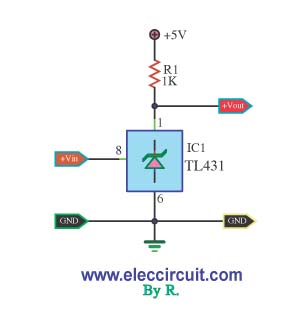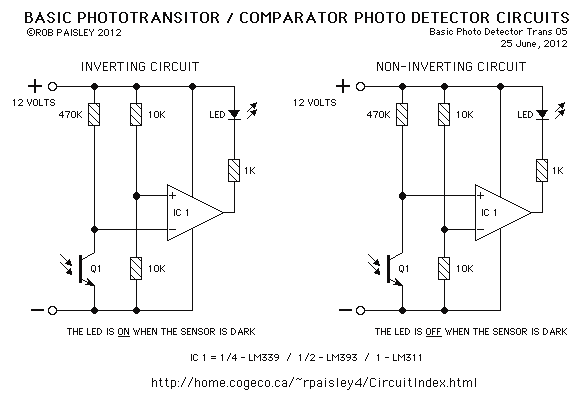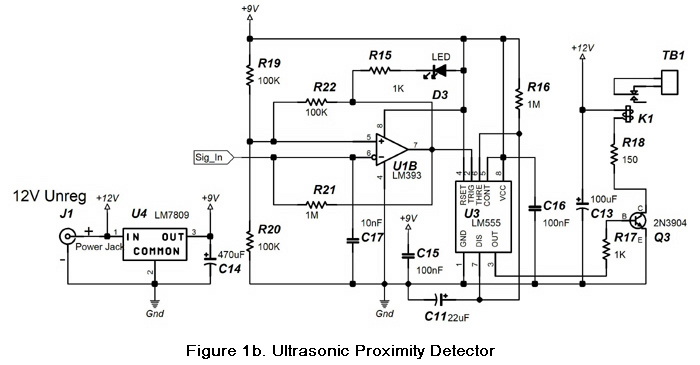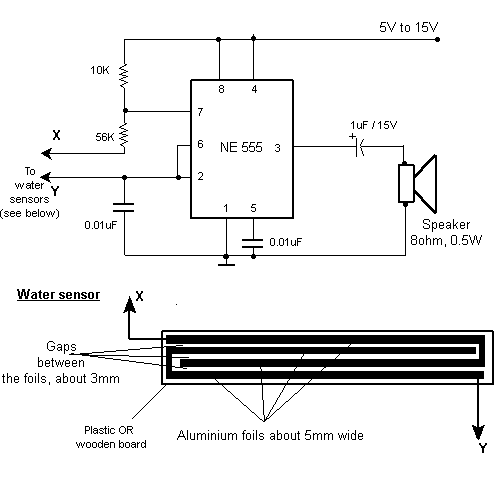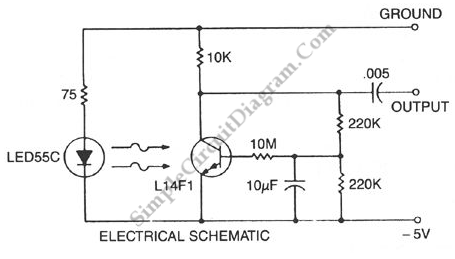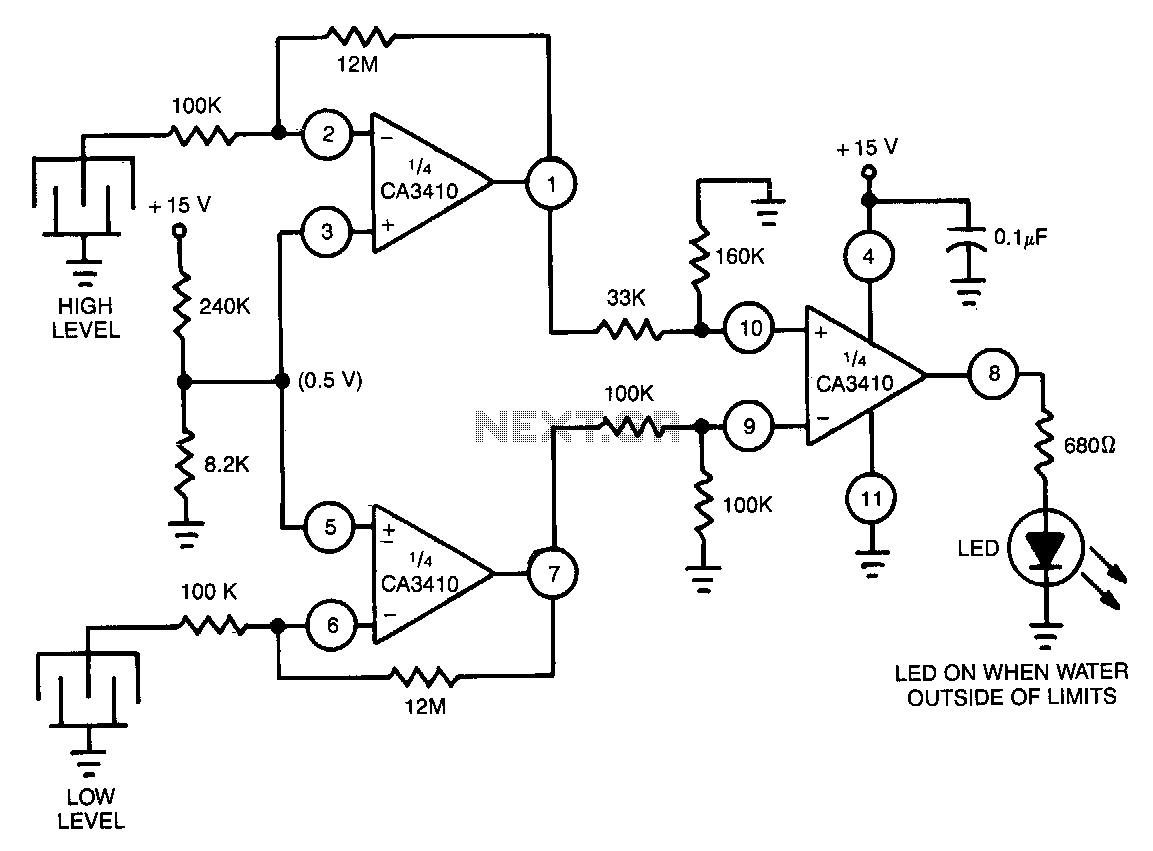
Low/Floating/High Detector
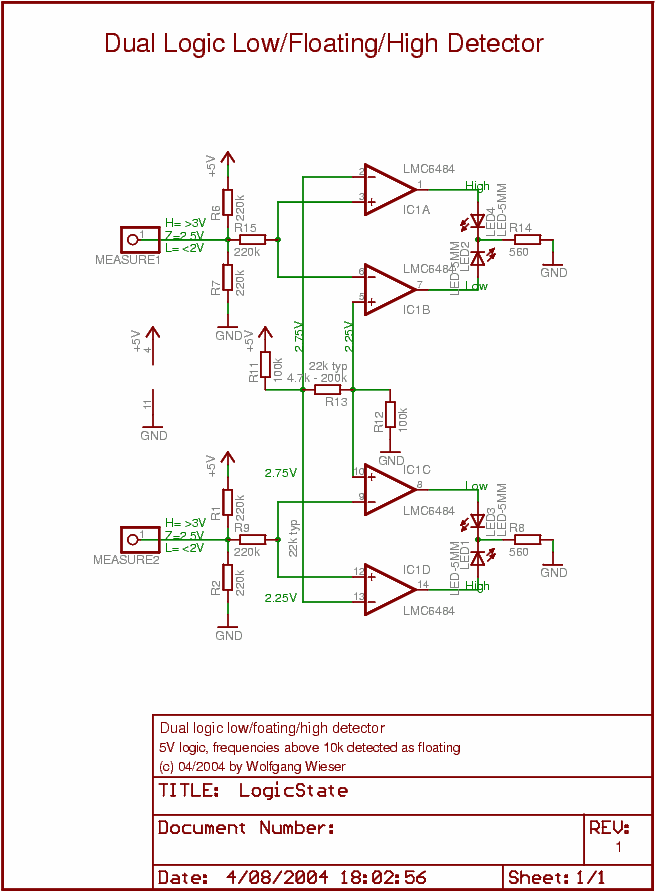
This circuit is a dual low/floating/high logic state detector that allows observation of the logic state of a digital signal pin. Each detector features two LEDs (typically one red and one green) to indicate the state: the red LED signifies a high state, the green LED indicates a low state, and no LED is lit for a floating state. The circuit can handle frequencies up to 10 kHz effectively, with both low and high LEDs illuminated. At higher frequencies, particularly above 100 kHz, the circuit displays a floating state (no LED illuminated). The design utilizes National's LMC6484, a cost-effective rail-to-rail amplifier that operates down to 3V. A single DIL-14 package contains four amplifiers, which are sufficient for two independent detectors. Resistors R6 and R7 bias the input at 2.5V (half of the supply voltage). When the signal pin connected to the measurement input is high or low, the voltage at the left side of R15 will either rise or fall. Two amplifiers are configured in comparator mode to compare this voltage against threshold values set by the voltage divider formed by resistors R11, R13, and R12. R13 is used to adjust the potential difference between the upper limit for low states and the lower limit for high states. Voltages that fall between these thresholds are considered floating. R15 serves as input protection for the amplifier, as recommended in the datasheet, ensuring that connecting the measurement pins without power applied does not harm the device. Resistor R14 limits the current through the LEDs; for a 5V supply and low current LEDs (2mA), a 560-ohm resistor is employed, resulting in approximately 4.5mA LED current. This value should be adjusted for operation at 3.3V or with different LED specifications.
The dual low/floating/high logic state detector circuit is designed to provide clear visual feedback on the state of a digital signal pin, making it an invaluable tool for debugging and testing digital circuits. The use of two distinct LEDs allows for immediate identification of the signal state, facilitating quick troubleshooting.
The LMC6484 operational amplifier, chosen for its rail-to-rail output capability, ensures that the circuit can operate effectively across a range of input voltages, enhancing its versatility. The biasing arrangement using R6 and R7 is critical, as it establishes a reference point that allows for accurate detection of high and low states. The comparator configuration of the amplifiers enables precise threshold detection, ensuring that the circuit responds appropriately to varying signal levels.
The voltage divider formed by R11, R13, and R12 is essential for setting the detection thresholds. By adjusting R13, the designer can fine-tune the circuit's sensitivity, accommodating different logic levels or signal characteristics. This flexibility is particularly useful in environments where signal integrity may be compromised or where different logic families are in use.
The inclusion of R15 as an input protection resistor is a prudent design choice, safeguarding the operational amplifiers from potential damage during testing or debugging scenarios. This feature enhances the durability of the circuit, allowing it to withstand accidental misconfiguration without failure.
R14's role in limiting LED current is also significant. By calculating the appropriate resistance value based on the supply voltage and desired LED current, the designer can ensure optimal LED brightness while preventing excessive current that could lead to premature LED failure. This attention to detail in component selection and configuration contributes to the overall reliability and performance of the circuit.
In summary, this dual low/floating/high logic state detector circuit is a well-thought-out design that balances functionality, reliability, and ease of use. Its clear visual indicators, robust protection features, and adjustable thresholds make it an essential component for anyone working with digital electronics.This circuit is a dual low/floating/high logic state detector which enables you to see the logic state of a digital signal pin. Each detector has two LEDs (typically a red and a green one) which indicate the state: red LED for high state, green LED for low and no LED for floating.
Frequencies up to 10kHz are properly handeled (low and high LED on) , higher frequencies (especially above 100kHz) are displayed like floating state (no LED running). The design is easily explained: National `s LMC6484 is a comparatively cheap rail-to-rail amplifier with guatanteed operation down to 3V. One DIL-14 package contains 4 amplifiers - just what is needed for two independent detectors. Using R6 and R7, the input is biased at 2. 5V (half supply voltage). In case the signal pin connected to the measure input is H/L, the voltage at the left side of R15 will rise/fall.
Using two amplifiers in comparator mode, this potential is compared to the threshold values available through the voltage divider R11, R13 and R12. R13 adjusts the potential difference between upper L limit and lower H limit. Voltages in between are considered heigher H nor L and hence floating. (R15 is used as input protection for the amplifier as suggested by the data sheed. Hence, it should not be harmful for the device to connect the measure pins when no power is applied. ) R14 is used to limit the current through the LEDs; for 5V and low current LEDs (2mA), I use 560Ohm resulting in about 4.
5mA LED current. Adjust that for 3. 3V operation and/or different LEDs. 🔗 External reference
The dual low/floating/high logic state detector circuit is designed to provide clear visual feedback on the state of a digital signal pin, making it an invaluable tool for debugging and testing digital circuits. The use of two distinct LEDs allows for immediate identification of the signal state, facilitating quick troubleshooting.
The LMC6484 operational amplifier, chosen for its rail-to-rail output capability, ensures that the circuit can operate effectively across a range of input voltages, enhancing its versatility. The biasing arrangement using R6 and R7 is critical, as it establishes a reference point that allows for accurate detection of high and low states. The comparator configuration of the amplifiers enables precise threshold detection, ensuring that the circuit responds appropriately to varying signal levels.
The voltage divider formed by R11, R13, and R12 is essential for setting the detection thresholds. By adjusting R13, the designer can fine-tune the circuit's sensitivity, accommodating different logic levels or signal characteristics. This flexibility is particularly useful in environments where signal integrity may be compromised or where different logic families are in use.
The inclusion of R15 as an input protection resistor is a prudent design choice, safeguarding the operational amplifiers from potential damage during testing or debugging scenarios. This feature enhances the durability of the circuit, allowing it to withstand accidental misconfiguration without failure.
R14's role in limiting LED current is also significant. By calculating the appropriate resistance value based on the supply voltage and desired LED current, the designer can ensure optimal LED brightness while preventing excessive current that could lead to premature LED failure. This attention to detail in component selection and configuration contributes to the overall reliability and performance of the circuit.
In summary, this dual low/floating/high logic state detector circuit is a well-thought-out design that balances functionality, reliability, and ease of use. Its clear visual indicators, robust protection features, and adjustable thresholds make it an essential component for anyone working with digital electronics.This circuit is a dual low/floating/high logic state detector which enables you to see the logic state of a digital signal pin. Each detector has two LEDs (typically a red and a green one) which indicate the state: red LED for high state, green LED for low and no LED for floating.
Frequencies up to 10kHz are properly handeled (low and high LED on) , higher frequencies (especially above 100kHz) are displayed like floating state (no LED running). The design is easily explained: National `s LMC6484 is a comparatively cheap rail-to-rail amplifier with guatanteed operation down to 3V. One DIL-14 package contains 4 amplifiers - just what is needed for two independent detectors. Using R6 and R7, the input is biased at 2. 5V (half supply voltage). In case the signal pin connected to the measure input is H/L, the voltage at the left side of R15 will rise/fall.
Using two amplifiers in comparator mode, this potential is compared to the threshold values available through the voltage divider R11, R13 and R12. R13 adjusts the potential difference between upper L limit and lower H limit. Voltages in between are considered heigher H nor L and hence floating. (R15 is used as input protection for the amplifier as suggested by the data sheed. Hence, it should not be harmful for the device to connect the measure pins when no power is applied. ) R14 is used to limit the current through the LEDs; for 5V and low current LEDs (2mA), I use 560Ohm resulting in about 4.
5mA LED current. Adjust that for 3. 3V operation and/or different LEDs. 🔗 External reference
